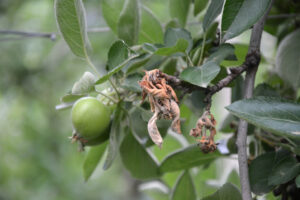Understanding Fire Blight

Fire blight is a devastating plant disease caused by the bacterium Erwinia amylovora, primarily affecting apple and pear trees, among other members of the rose family. It manifests through symptoms including blackened leaves, flowers, and branches that give the appearance of having been burned by fire. Fire blight treatment need to be aggressive and early. The disease progresses rapidly in warm, moist conditions, and can decimate entire orchards if not promptly and effectively managed.
The Causative Agent: Erwinia amylovora
Erwinia amylovora, a gram-negative bacterium, is the causal organism behind the aggressive fire blight disease. The pathogen can survive on its host plants, colonizing tissues and secreting enzymes that break down cellular walls, leading to tissue necrosis. Its ease of spread through rain, insects, and contaminated pruning tools makes it an adversary that is hard to combat and highlights the necessity for strict adherence to control measures in affected areas.
Signs and Symptoms of Infected Plants
Infected plants exhibit a series of distinct symptoms that can help gardeners and orchard managers identify fire blight. Early signs include a watery, light tan ooze that emanates from the infected areas. As the disease progresses, flowers and shoots suddenly wither and blacken, often bending into a characteristic ‘shepherd’s crook’ shape. Leaves and fruit attached to infected branches also blacken and appear as if scorched by fire, hence the name. These symptoms typically appear during spring and early summer and can swiftly progress, affecting not only the current year’s growth but also the underlying woody tissues, potentially killing the plant.
Cultural Control Measures
Importance of Site and Cultivar Selection
Selecting the appropriate site and cultivar is critical in minimizing the impact of fire blight. Ideal orchard locations are those with good air circulation, which helps to quickly dry moisture on leaves and flowers, thereby reducing the disease’s ability to take hold. Cultivar selection is equally important as some varieties possess greater resistance to Erwinia amylovora. Growing resistant cultivars can significantly diminish the prevalence and severity of fire blight outbreaks. Careful consideration in choosing the right site and cultivar not only enhances the overall health of the plants but also lessens the reliance on chemical treatments, fostering a more sustainable and eco-friendly approach to orchard management.
Sanitation Practices to Reduce Spread
Implementing rigorous sanitation measures is vital in managing fire blight. Pruning is a core component of these practices, where gardeners must remove and destroy all infected plant material, including branches, twigs, and fruits. It is essential to sterilize pruning tools between cuts using a solution of one part bleach to nine parts water or a 70% alcohol solution to prevent spreading the bacteria to healthy tissue. During the growing season, promptly removing infected blossoms can also help curtail the spread of the disease. Sanitation extends to fallen debris; regularly clearing away fallen leaves and fruit lessens the potential for infection, as these can harbor the bacteria over the winter.
Balanced Watering and Fertilization Techniques
Proper watering and fertilization are crucial in the management of fire blight, as excessive growth can make plants more susceptible to infection. Watering should be done in a manner that maintains consistent soil moisture but avoids waterlogging, which can stress plants and invite disease. Similarly, fertilization should aim to support steady, healthy growth without causing a flush of tender new shoots that are particularly vulnerable to Erwinia amylovora. Utilizing slow-release fertilizers and adhering to extension service recommendations for nitrogen levels can help achieve the desired plant vigor without tipping the scales toward excessive growth and increased blight risk.
Chemical Control Options for Fire Blight
Utilization of Bactericides
When cultural practices alone are insufficient to control fire blight, the judicious use of bactericides can be a key line of defense. Copper-based sprays are effective as a preventative measure during times of high risk, such as the bloom period. However, the timing of the application is critical to protect the blossoms from infection while minimizing copper toxicity to beneficial insects. Additionally, the use of antibiotics like streptomycin or kasugamycin, approved in certain areas, can help control the spread if applied shortly after initial infection signs. It’s imperative for gardeners to follow the label instructions and regional guidelines to prevent the development of resistant bacterial strains.
Timing of Application
To maximize the efficacy of bactericides in combating fire blight, attention to timing is essential. Applications are most effective when done just prior to the first blooms opening and may continue at regular intervals as suggested by local extension service calendars, especially during wet spring weather when the disease is most likely to spread. Late applications are generally discouraged as they are less effective and increase the risk of developing resistant strains of bacteria.
Recommended Products
For preventative care, fixed copper fungicides are commonly recommended for application before the flowering stage. These products include options such as Bordeaux mixture or more modern formulations like copper octanoate. If the use of antibiotics is permitted and warranted, products containing streptomycin sulfate or oxytetracycline hydrochloride should be considered due to their proven effectiveness against fire blight.
Antibiotics as a Treatment (Where Permitted)
In regions where the use of antibiotics for fire blight is allowed, a treatment regimen must be approached with care. Streptomycin and oxytetracycline, often sold under various trade names, can suppress the development of Erwinia amylovora when applied during the early stages of infection. However, it’s critical to follow the specified resistance management guidelines and use antibiotics in rotation with other control measures to minimize the risk of the bacteria developing resistance.
Resistance Management Concerns
The potential for pathogenic bacteria to develop resistance to common bactericides remains a serious concern within agricultural communities. Resistance management strategies are imperative to safeguard the effectiveness of these treatments. Integrating non-chemical control methods, such as pruning and removal of infected plant materials, and using bactericides judiciously are key to avoiding over-reliance on any single type of control method. Regular monitoring for signs of resistance, compliance with recommended usage rates, and adherence to rotation schedules with different modes of action, help in mitigating the risk of resistance development. It is also crucial for growers to stay updated with local agricultural extension services for region-specific resistance management advice.
Biological Control and Integrated Pest Management (IPM)
Biological control agents have emerged as a cornerstone in Integrated Pest Management (IPM) strategies. Utilizing naturally occurring predators, parasitoids, and beneficial pathogens, these agents can effectively target and suppress pest populations, including the infamous Erwinia amylovora. Implementing biological controls can reduce the dependence on chemical options and contribute to a more sustainable and environmentally friendly approach to agricultural pest management. This harmonious alliance with nature not only helps in controlling fire blight but also promotes overall ecosystem health.
IPM plays a pivotal role in managing fire blight, a treacherous plant disease affecting a variety of fruit trees. Through the application of IPM principles, farmers can employ a multi-faceted strategy that focuses on prevention, monitoring, and the least toxic control methods. By emphasizing regular orchard inspections and accurate diagnosis, IPM enables growers to intervene early and effectively, often utilizing environmental forecasts to anticipate disease outbreaks. By integrating cultural practices, such as controlling irrigation to avoid excess moisture, alongside biological control agents, IPM aims to create an agricultural environment less conducive to the spread of fire blight, thus reducing the need for extensive chemical intervention.
Effective biological treatments for fire blight include the usage of antagonistic bacteria such as Streptomyces lydicus and Bacillus subtilis. These beneficial microorganisms can outcompete Erwinia amylovora for nutrients and space, effectively inhibiting its growth. Additionally, the application of certain strains of Pseudomonas fluorescens has been shown to suppress fire blight by producing antibiotics that target the pathogen. Each of these treatments functions as part of an overall IPM strategy, offering a more ecologically sound approach to managing this devastating plant disease.
Pruning and Removal Strategies
Prudent pruning techniques are paramount in managing fire blight. During the dormant season, it is advisable to prune affected branches at least 8 to 12 inches below the visible signs of infection to ensure the complete removal of all diseased tissues. It’s essential to make these cuts with precision to avoid unnecessary wounding of the plant, which could provide entry points for pathogens.
Sanitation of equipment cannot be overstressed. Tools used for pruning should be meticulously sterilized before and after each cut, especially when moving between healthy and infected trees. A solution of one part bleach to nine parts water, or a 70% alcohol solution, can be utilized for disinfecting pruning shears and saws. This rigorous sanitation helps to prevent the spread of Erwinia amylovora within and between orchards.
Equally important is the disposal of infected plant material. Once removed, the diseased branches and debris should be burned or buried to eliminate any sources of inoculum that could infect new growth. Open-air burning, where permitted, is an effective method to destroy the bacteria, while burying should be done deeply enough to prevent contact with surface soil or plant material. Proper disposal acts as a critical containment measure to halt the cycle of infection.
Fire blight can’t be cured, only treated. This being the case, if you have other trees, removing the infected tree may be the best course of action.
Resistance Breeding and Future Outlook
The quest for fire blight-resistant plant varieties is a cornerstone of long-term management strategies. Recent advancements in genetic research have shed light on the complex interactions between Erwinia amylovora and its hosts, paving the way for the development of trees with innate resistance. Modern biotechnological techniques, such as gene editing and marker-assisted selection, are being utilized to enhance the resilience of popular cultivars without compromising the quality or yield of fruit. Studies have identified several genes that confer resistance, and ongoing efforts continue to introduce these into susceptible varieties through breeding programs.
In parallel with these scientific endeavors, extension services play a vital role in disseminating knowledge and raising awareness among growers. These entities act as bridges between researchers and the farming community, ensuring that the latest insights into fire blight management and resistance breeding are effectively communicated and adopted in practice. Extension services conduct workshops, publish guidelines, and provide on-site consultations to support orchardists in implementing cutting-edge techniques that protect their crops. The role of such educational outreach is crucial, not only in conveying information but also in fostering an adaptive mindset among growers to readily embrace innovative solutions for controlling fire blight.
Conclusion
In conclusion, fire blight remains one of the most destructive and challenging diseases in the fruit industry. Its complex nature and rapid spread make it a constant threat to orchards worldwide. However, with ongoing research and advancements in resistance breeding techniques, there is hope for effective long-term management strategies.
By understanding the life cycle of infection, implementing integrated pest management practices, and

